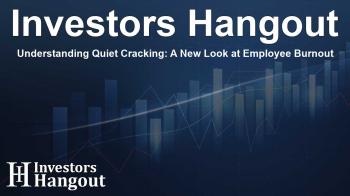Understanding Quiet Cracking: A New Look at Employee Burnout

Understanding the Phenomenon of Quiet Cracking in the Workplace
Recent findings shed light on a significant issue facing employees today called "quiet cracking." This term refers to a troubling situation wherein workers meet their job responsibilities while battling burnout, emotional fatigue, and disengagement from their work. The latest survey indicates that nearly six out of ten employees report struggling with this phenomenon.
The Prevalence of Quiet Cracking
When observing the survey results, it becomes evident that this issue is widespread. Approximately fifty-nine percent of employees feel they are quietly cracking, with twenty percent admitting they have recently experienced similar challenges. Alarmingly, some individuals have dealt with this for more than a year. Age demographics reveal an interesting pattern: younger generations, including Gen Z and Millennials, are more affected, showcasing rates of seventy-two percent and sixty-five percent, respectively.
A Closer Look at Affected Groups
This trend represents a larger issue within the workforce, as figures indicate that older generations, such as Gen X and Baby Boomers, experience lower rates of quiet cracking, at fifty-one percent and twenty-nine percent, respectively. Additionally, men seem to face more challenges than women, with sixty-two percent of men reporting struggles compared to fifty-six percent of women.
Identifying the Causes Behind the Trend
So, what has led to this alarming rise in quiet cracking? Workers point to excessive workloads and personal stress as the main culprits. Forty-three percent attribute their condition to overwhelming job demands, while forty percent cite struggles in their personal lives. Other contributing factors include poor leadership, repetitive tasks, insufficient compensation, and a lack of opportunities for growth.
The Role of Management in Alleviating Stress
Julia Toothacre, Chief Career Strategist, emphasizes the role that effective management plays in mitigating these issues. According to her, when workloads exceed reasonable limits under ineffective leadership, anxiety levels rise. It underscores the necessity of regular check-ins and proactive efforts from managers to prevent emotional exhaustion among their teams.
Recognizing Signs and Symptoms of Quiet Cracking
How can one recognize if they or their colleagues are quietly cracking? The symptoms vary but often include emotional fatigue and dread about the workday, affecting fifty percent of those impacted. Others report a negative outlook toward their job and sleep issues, with some experiencing headaches, tension, decreased creativity, and an increase in mistakes.
Developing Coping Strategies
While confronting these challenges, many workers find it essential to employ coping mechanisms. Taking time off work (forty-three percent) and seeking new job opportunities (thirty-six percent) are among the most common approaches. Many also find relief by talking to trusted individuals, engaging with managers for support, or requesting more flexibility in their roles.
The Implications of Quiet Cracking on Employee Retention
It is essential to note that there is a direct correlation between experiencing quiet cracking and the intention to leave a job. Statistics reveal that nearly two-thirds of workers affected are contemplating leaving their current positions within six months. This shows a troubling trend that employers need to address.
Strategies for Management and Employees
While changing jobs can seem to be the most straightforward solution, experts advise identifying the underlying issues before making such decisions. Understanding personal challenges can prevent the cycle of dissatisfaction from repeating in a new environment, emphasizing the importance of thorough reflection.
Frequently Asked Questions
What is quiet cracking?
Quiet cracking refers to the condition where employees fulfill their job duties while struggling with burnout and emotional fatigue.
What are the main causes of quiet cracking?
The primary causes include excessive workload, personal stress, poor management, and lack of recognition or opportunities for growth.
Who is most affected by quiet cracking?
Younger generations such as Gen Z and Millennials are more affected, with rates significantly higher than older generations.
What symptoms should I look for?
Common symptoms include emotional fatigue, dread of the workday, negative work outlook, sleep issues, and physical symptoms like headaches.
What can be done to address quiet cracking?
Both management and employees can take proactive steps, such as regular check-ins, encouraging open communication, and exploring coping strategies to handle stress better.
About The Author
Contact Lucas Young privately here. Or send an email with ATTN: Lucas Young as the subject to contact@investorshangout.com.
About Investors Hangout
Investors Hangout is a leading online stock forum for financial discussion and learning, offering a wide range of free tools and resources. It draws in traders of all levels, who exchange market knowledge, investigate trading tactics, and keep an eye on industry developments in real time. Featuring financial articles, stock message boards, quotes, charts, company profiles, and live news updates. Through cooperative learning and a wealth of informational resources, it helps users from novices creating their first portfolios to experts honing their techniques. Join Investors Hangout today: https://investorshangout.com/
The content of this article is based on factual, publicly available information and does not represent legal, financial, or investment advice. Investors Hangout does not offer financial advice, and the author is not a licensed financial advisor. Consult a qualified advisor before making any financial or investment decisions based on this article. This article should not be considered advice to purchase, sell, or hold any securities or other investments. If any of the material provided here is inaccurate, please contact us for corrections.

